Life-long friends are an invaluable pleasure, and utterly irreplaceable.
Growing up in small town Sheffield, Illinois, five of us became acquainted weeks after birth, traversed grade school, high school, and attended college together. Our moms worked as Cub Scout den mothers, elementary school teachers, housewives, and grocery store cashiers. Our dads melded as carpenters, electricians, farmers, and entrepreneurs. Although five inches shorter and forty pounds lighter, the Korean War vet carpenter carried my farmer dad off a grain elevator when vertigo struck him down. The electrician raised seven children by himself when his beloved wife passed in her 30’s. The entrepreneur always gave me work when I needed cash to pursue an education. He didn’t need me, but he knew I needed him. Some people scoff at the idea that it takes a village.
I don’t.
Amazingly, we all married wonderful spouses who get along. We don’t assemble for years on end, which doesn’t matter because we fall right into place the minute we’re reunited, and the laughter doesn’t cease until we say goodbye. A blessed thing, indeed.
We usually rendezvous in a city known for music, and this year we met in Austin, Texas. Three friends and their spouses flew in from Chicago and Seattle, one couple drove down from Dallas, and my wife and I cruised the 3,000 mile lap from Johnson City, Tennessee in the old Prairie Schooner, a 2006 Ford F-150 outfitted for camping.
We enjoyed a brief respite at historic Pulaski, Tennessee, where the KKK was born, but its first leader, Nathan Bedford Forrest, pulled out when he saw it was going too far. These days you can still get a 5 cent Coke at the local drug store. Pulaski is named after the Polish-born revolutionary war hero, and Sam Davis, a Confederate courier, was hanged by the Union Army as a spy at this locale. Quaint little town with a marvelous courthouse.
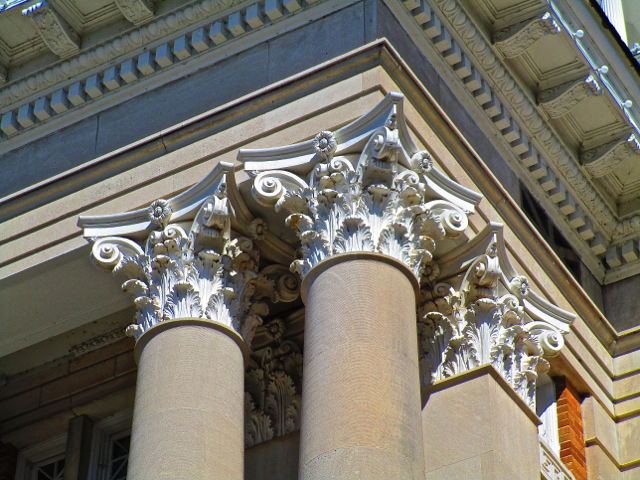
Shiloh National Battlefield was our first major stop, which serendipitously occurred on the 154th anniversary of the battle, April 6-7, 1862.
Civil War buffs know that Shiloh, Antietam, and Gettysburg were similar in that one side held the advantage at a point in the conflict but did not act to annihilate their adversaries in the window of opportunity, thereby extending the war. The Confederates, under their crack General Albert Sidney Johnston, held the advantage at the end of the first day at Shiloh — ironically Hebrew for “the peaceful one” — and bottled up the Union Army of the Tennessee under U. S. Grant at Pittsburg Landing at the eastern edge of the battlefield with the Tennessee River to their back.
With Sherman’s troops by his side, Grant knew his whole army could be destroyed. But Johnston was hit under the knee with a Minié ball and bled out while in command, and died on the field. The second in command, P.T.G. Beauregard, lacked the conviction to pursue the advantage. The next morning the Union counter-attacked after being reinforced by troops marching down from Nashville, and drove the Confederates back to Corinth, Mississippi.
Shiloh was the first major battle of the Civil War, and 23,746 soldiers were killed or wounded in those two days, casualties that surpassed all the U.S. wars to that date. By the end of four years of Civil War 204,000 American soldiers perished. The combined death toll of both Iraq and Afghanistan Wars to this date equals 6,831.
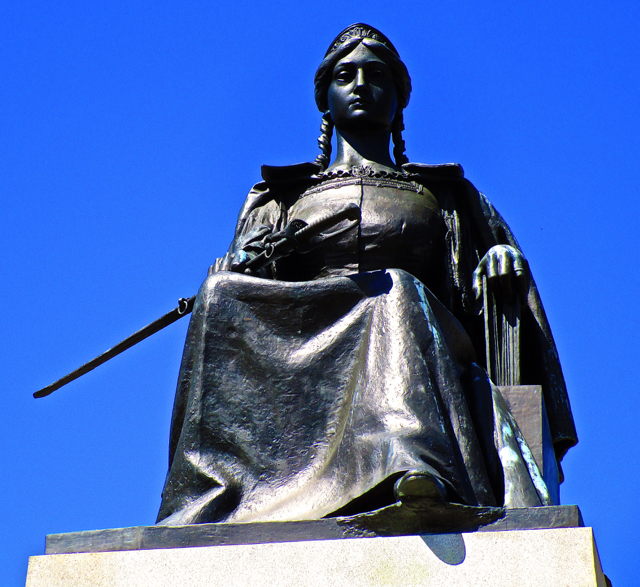
Shiloh Methodist Meeting House sitting in the middle of the conflict lent its name to the battle. The log cabin structure still stands next to a newer edition church which flaunts four layers of building materials due to the fact that construction started and stopped over the years until it was finally completed in 1949.

After a wonderful spring day spent perusing placards and photographing the historic site, we enjoyed an evening at the gorgeous Pickwick Landing State Park on the Tennessee River near the border of TN-AL-MS.

The next day we cruised down the two-lane Natchez Trace — similar to the Blue Ridge Parkway in that it’s overseen by the Department of the Interior — running beside parts of the ancient trace linking New Orleans to Nashville, and spending the night in Natchez, a famous port on the Mississippi.

All of our trips end up earning a “catchphrase” from something we heard on the jaunt, and during this trip we turned on the radio in the middle of Mississippi just as a talk radio show was discussing the Zika virus.
“Whatever you do, don’t put Deet© on the baby,” said the announcer. After a pregnant pause, he repeated: “Don’t put Deet© on the baby!” We had difficult time not sharing this wisdom every time we saw a parent with a little one in tow.
Our stay in Natchez produced the best meal of the trip, at the Magnolia Grill “under the hill” where historically all the gambling, horse racing, and encounters with “wild women” took place back in the day when the Mississippi was America’s interstate highway. The perfectly prepared quail stuffed with dirty rice and duck will not be forgotten.
We slept in a historic bed and breakfast above the river where President of the Confederacy Jefferson Davis married his beloved Verena Howell in 1845 and we toured the city the next day, mingling with visitors from around the globe. If you are a history buff, the author who penned Forrest Gump — Winston Groom — writes wonderful non-fiction about Civil War conflicts in and around Mississippi and I highly recommend his works Shiloh and Vicksburg.
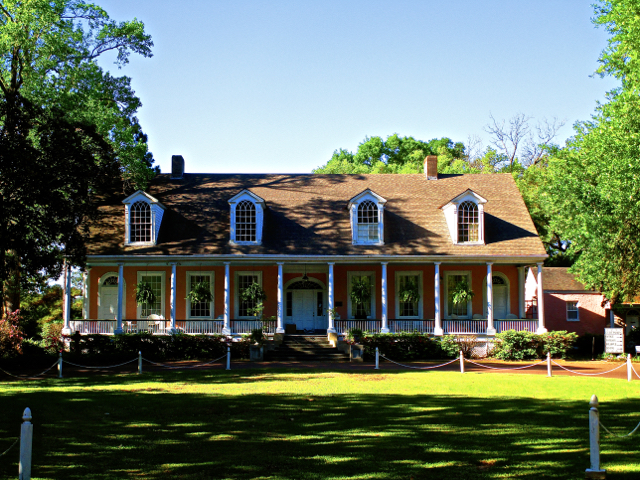
Natchez is steeped in history and if you are lucky enough to be there during their annual Pilgrimage (5 March to 5 April) the town puts on a play with period costumes and music that is truly wonderful. We were able to see it years ago on another trip and we still reminisce about the effort and joy the townspeople put into this production.
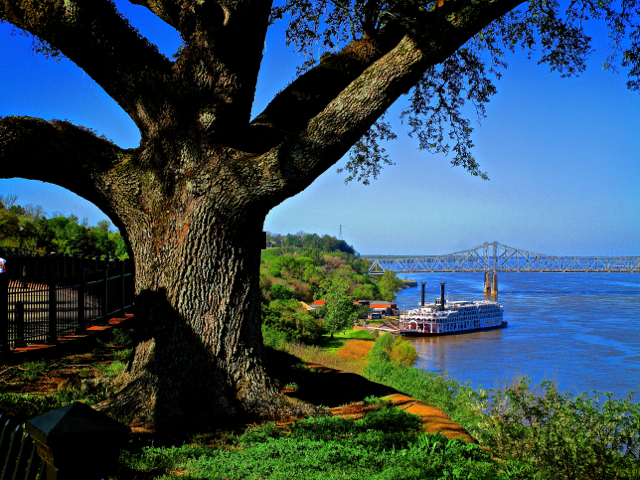
From Natchez we wandered across Louisiana on Route 84 to Alexandria and then took Route 28 to the Texas border. After spending the night in Livingston, Texas, we wandered down to scenic Rockport on the Gulf, enjoyed a wonderful meal and local art at Latitude 28 02, then ferried to Port Aransas spent three days on Mustang Island, walking the beaches, watching the campers and fishermen enjoy the fine weather, and loading up on fresh seafood and local craft beer.
We’d always heard others talk admiringly of San Antonio, and the city not only lived up to the hype, but it exceeded expectations. From The Alamo (cottonwood in Spanish) to the River Walk, to the restaurants and museums, this gem of an American city is steeped in Hispanic culture. No way can I imagine a walled border and eleven-million deportees.
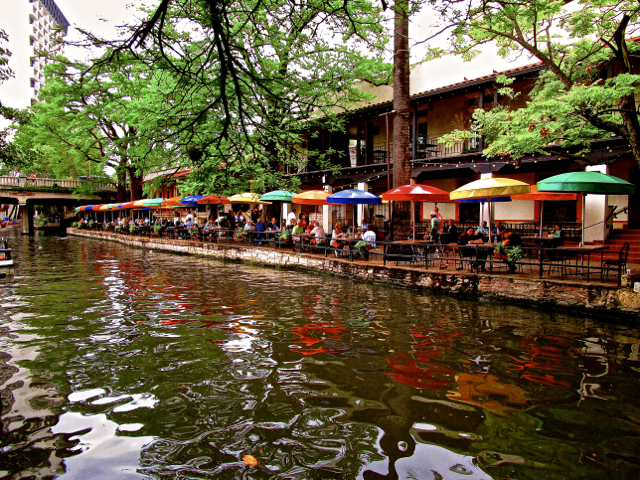
Diversity is our strength, ladies and gentlemen. You can put on blinders, but this nation is built on combined effort. From the Hispanic workers laying bricks inside the new renovations at the World Heritage Mission Sites to the Hispanic U.S. servicemen walking the San Antonio streets, it’s obvious that regardless what boat your ancestors came over on — be it luxury liner, Spanish galleon, Boston slave ship, the Mayflower, or Chinese junk — we’re all in the same boat now. The sooner we stop stabbing each other in the back and start pulling together again, the quicker we become even greater as a nation. Seeing these bustling Texas cities first hand and soaking up their collective history will bolster your confidence in what a great nation we already enjoy.
Leaving San Antonio for Austin, we travelled through the “Cowboy Capital of the World” — Bandera — where Polish immigrant milled cypress logs into shingles to roof San Antonio homes. You can still see the cypress trees growing alongside the meandering Medina River.
The Texas hill country between Bandera and Fredericksburg is a motorcyclist’s dream-come-true with rolling landscape, live oaks, lots of curves, pastures full of sand blue bonnets and Indian paintbrushes, and picturesque horse ranches. We barreled along in the Prairie Schooner but dreamed of returning for a future motorcycle excursion.
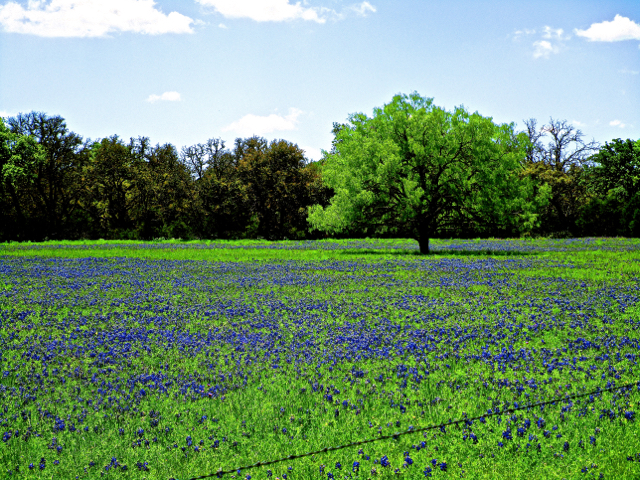
We stopped in Fredericksburg, a small Texas down founded by German immigrants in 1846 and enjoyed walking the city in order to photograph the limestone structures, historic B&B’s, churches, and the site of the Admiral Nimitz Museum, a truly incredible must-see.
The LBJ Ranch lay between us and our destination, and we only had two hours left before closing time, but the effort paid off as we had the place to ourselves. There are sites in this world that exude a certain ambiance. For example, Appomattox Courthouse in Virginia, where Confederate troops laid down their weapons in surrender while the Union soldiers respectfully saluted their undeniable bravery, lends an air of historic gravity. This can only be experienced, not explained. President Johnson’s ranch reverberates with peace and tranquility. You quickly understand why he retreated to this idyllic setting to escape the rigors of the multiple problems raining down on his presidency in the late 60’s. Two days after this visit we returned with the gang and listened to Lucy Baines Johnson exhort visiting high school classes and visitors to use our lives to serve and to improve America.

Driving to Austin after the first LBJ stop, we passed dozens of wineries dotting the landscape; one fruit farm displayed red poppies in full bloom beneath their peach trees.
Luckenbach, Texas came into view early in the afternoon and we stopped to chat with motorcyclists and other visitors enjoying the ambiance of the few green acres Willie, Waylon and the Boys made famous with that eponymous triplet of a town.

Arriving in Austin in the early evening, our gang of old friends met us at the door of the five-bedroom Rent-by-Owner house on West 9th Street and the laughs never subsided. This artist-laden neighborhood reminded us of Portland, Oregon with its narrow streets, eclectic architecture, blooming trees, and young-person vibe. We drew lots for bedrooms, never turned on a television, and acted like college kids for five days, enjoying music sites around the city, seeing a Kurt Vile concert at the famous Stubbs venue, dancing at The Broken Spoke to the wonderful two-step band The Derailers, and talking each night into the early morning hours. Parting on Monday wasn’t difficult as we knew we’re always together in heart.
As it turned out, there was a group of young people next door partying their brains out, and we discovered that they were old high school friends reuniting for the first time since graduating. One of their group told us that he was worried that they would split up over the years, but seeing us together (we left high school forty-two years ago) gave him hope!
Lana and I blew out of town in the late afternoon and we nearly made it to Longview before dark, but chose to stay in Kilgore and visit a branch of the famous Bodacious Barbeque restaurant. BBQ throughout Texas is divine, especially when they start stuffing pork with beef. You would blow up like the Hindenburg if you lived there without practicing restraint.
From Kilgore we drove to Hot Springs, Arkansas and I stepped back in time when I visited the old Buckstaff House for a spa, which reminded me of the 1994 Anthony Hopkins film “The Road to Wellville” about the Kellogg brothers offbeat health spa. You begin by soaking in a large claw-foot tub filled with 105 degree mineral water, then try to survive a scalding sitz bath for tickling the old prostrate, then you lie on your back wrapped in hot towels, and finally you stand in a “needle shower” before lounging in the cooling room as your temp returns to normal. The only way to follow that up was by sipping a craft beer and nibbling a fried Arkansas bologna sandwich next door at the Superior Bathhouse Brewery. Hot Springs is gifted with incredible architecture from 1832 (when the federal government preserved the hot springs flowing from the mountain behind “bathhouse row”) to the mid-20th Century. Gangsters, gamblers, politicians, movie stars and baseball players used the famous Arlington Hotel for their headquarters. Lake Ouachita outside of town is an endless venue for camping, canoeing, fishing, and motor boating.
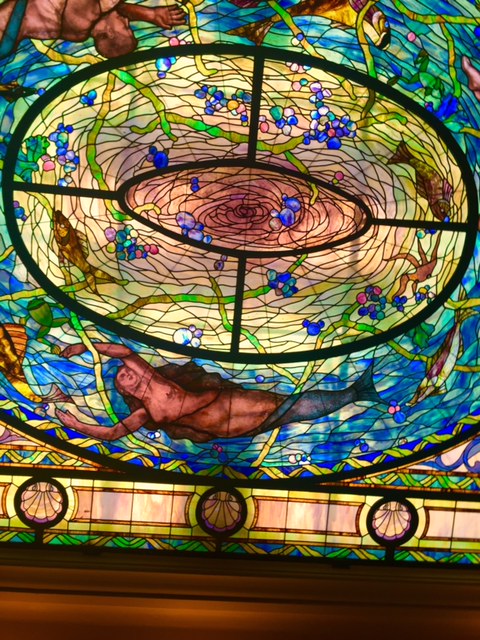
The next morning we motored into Little Rock and visited the Clinton Library and Museum. The President’s Georgetown classmates raised $30 million to put the library in Washington, but he refused the offer. When the Little Rock’s city officials asked the POTUS where he wanted his library, he said it needed to be placed in the dilapidated neighborhood next to the Arkansas River. They balked because that was the “nasty side of the city” but after a 2 billion dollar investment the gorgeous grounds, parks, and parking lots full of buses have brought in 3.3 billion dollars worth of investments. He derived the same positive economic expansion in Harlem with the Clinton Foundation.
The museum brought back to mind the many accomplishments of the Clinton presidency despite the logjams created by incipient obstructionists — Newt Gingrich is quoted on the timeline saying: “I think that one of the problems we have in the Republican party is that we don’t encourage you to be nasty” — notably balancing the budget, returning coffers to the black side of the balance sheet, winning record-breaking peace and prosperity, and surviving the failed impeachment proceedings because sane Republicans wisely voted it down.
Bill Clinton was indeed our first “black president” because MLK’s “I have a dream” speech affected his heart to the point where he actually gave people through appointments the opportunity to fulfill their destinies.
One gentleman from New York I met in the library beamed with pride as we talked about how the Clinton presidency proved that people working together can lift the entire nation to new heights. May we begin to do it again. Uniting works. Dividing fails. If you do not believe that, read a little American history. Both scenarios have occurred time and again. For every Lincoln there’s a Taft. For every Roosevelt there’s a Hoover. After eight years of obstructionism, we need to get ourselves up and rolling again.
From Little Rock to Jackson, Tennessee we suffered our first bout of Interstate Frenzy, and it sucked. Instead of seeing the country, when you travel the Interstate all you see are giant trucks weaving in and out of your lane, idiots texting on cell phones causing sweat to bubble up on your forehead, casino signs or advertisements for lawyers wanting to cash in on mesothelioma. Yick.
We love to smell the roses. If it takes a few more days, so be it. If we had to run the Interstates on vacation, I think we’d just run hot pokers up our behinds and make up a story about taking a trip, which would save time and aggravation.
We thankfully exited the Interstate and returned to the Natchez Trace in Mississippi before slipping into Tennessee in order to visit the Meriwether Lewis burial site near Tupelo. Thomas Jefferson picked Lewis to lead the Corps of Discovery from St. Louis to the Pacific coast in order to find a water route linking east to west. They followed the Missouri River until it petered out at its source in Montana; then they had to make their way afoot and on horseback until they connected with the Columbia. Perusing Stephen E. Ambrose’s “Undaunted Courage” is a wonderful way to research this historic mission. Ambrose devoted a detailed section on Lewis’ demise on the Trace, and it was chilling to walk the same ground where Lewis chose to end his life in 1809, just three years after his return from Oregon.

One item on our bucket list is to read and follow Lewis’ journal while camping along the same route the Corps of Discovery took to unlock the west.
That evening we enjoyed Jackson, Tennessee, a growing town boasting a new AA baseball stadium on its eastern outskirts, and we loaded up one more time on pork ribs (killer BBQ at Reggie’s off exit 85); then we sauntered over to the the new ball field and watched the Jackson Generals defeat the Birmingham Bears while we sipped craft beer and ate salted peanuts. Somebody’s got to do it.

The next morning we stayed on blue highways skirting the plateau through the middle of Tennessee, stopping to look at Rock Island State Park, and watching the cone-lickers stroll around the antique shops in Bell Buckle, residing in the heart of Tennessee Walking Horse country, which is quite similar to the horse farms near Lexington, Kentucky with their sprawling acres, white fences, federal-style mansions, and well-appointed horse barns. One has to wonder where all the money originates. Rich Nashvillians leveraging their cash, perhaps?

We arrived back in Johnson City late on Saturday night, the rigors of the three-week adventure shoe-horning us into our comfortable beds, belly rolls uncounted, Texas BBQ filling our dreams, our smiling church family welcoming us back into the fold the next morning. Like our old high school friends, this loving group is invaluable to our personal well-being.
In retrospect, Texas in the midst of a wet spring is exceedingly beautiful, the people quite friendly, the history deep and thought-provoking.
If you are blessed with the opportunity to see this amazing state, enjoy the BBQ, relax and avoid the Interstate when possible, revel in the coastal seafood, soak in the hill country, dig the music scene, and don’t put Deet© on the baby!
And if you are lucky enough to have life-long friends who love to travel, make the effort to meet them in a foreign city some day. Shared experience tightens those bonds. And memories, like old friendships, remain utterly irreplaceable.
***
View the entire photo collection of the Texas Trek (April 2016)
***
Read about our Cornwall – Devon excursion in 2015.

This is beautiful. Thank you for sharing. You can never underestimate the wonderful things that come out of a small village upbringing. It is no wonder they produce beautifully kind and productive citizens. God Bless.
LikeLiked by 1 person
So true! Thanks for the positive feedback. Much appreciated!
LikeLike
Beautiful words and photos!
LikeLiked by 1 person
Thanks for reading. Hug accomplished!
LikeLike
Love this.
LikeLiked by 1 person
Thanks for reading and sharing. Smack.
LikeLike
Mike, thanks for sharing. As always you make us feel like we went on the trip. Great pictures that brought back some of my own memories. Thanks for sharing yours.
Brian
LikeLike
Enjoyed the photos and descriptions. I can only absorb a little bit of the factual information you shared because I really have to work to remember history – but I valued so much the feeling which reached out of the narrative to wrap me in the warmth of the kind of comfortable, familiar friendships that withstand the tests of time and distance. From catch phrases that stick, to traditions that evolve, to the encouragement that shines even in just a look or a hug. Thanks Mike for taking the time and making the effort to share.
LikeLike
Loved this! I almost feel like I went along for the ride. I can’t begin to tell you how many times people ask me if I’m from the mid-west ..because I’m so friendly they say. That’s how it is as we travel across the u.s. whether by train or plane, the closer you get to home, the nicer people are. I miss home.
LikeLiked by 1 person
Your smile is indelible and authentic, Diane. That’s the first thing that comes to mind when people think of you, I believe. And you’ve always been that way!
LikeLike